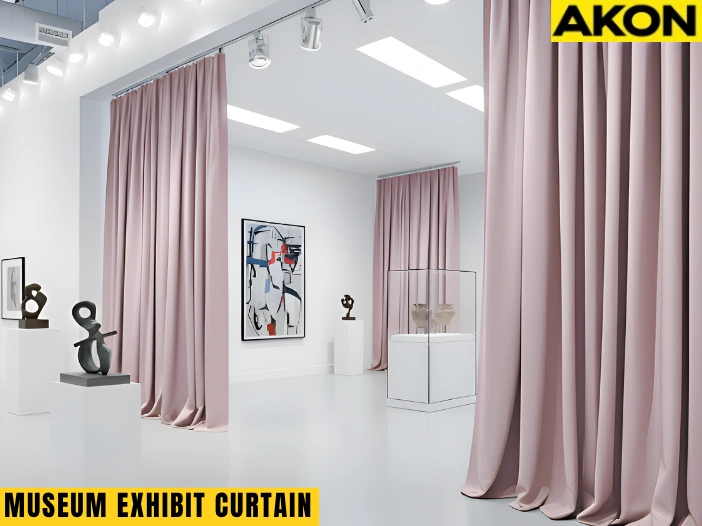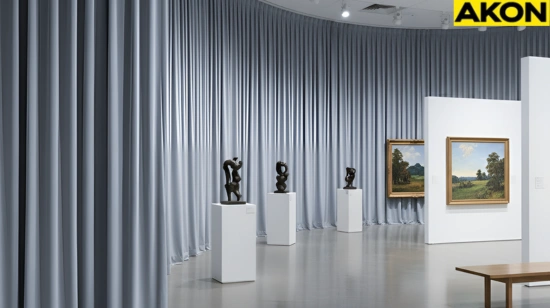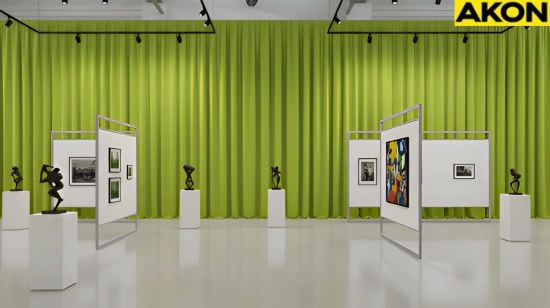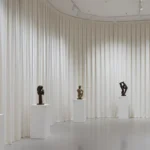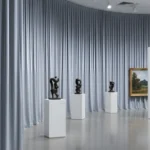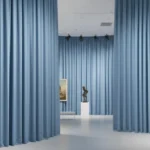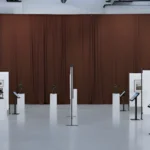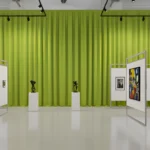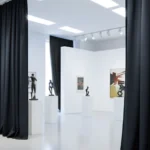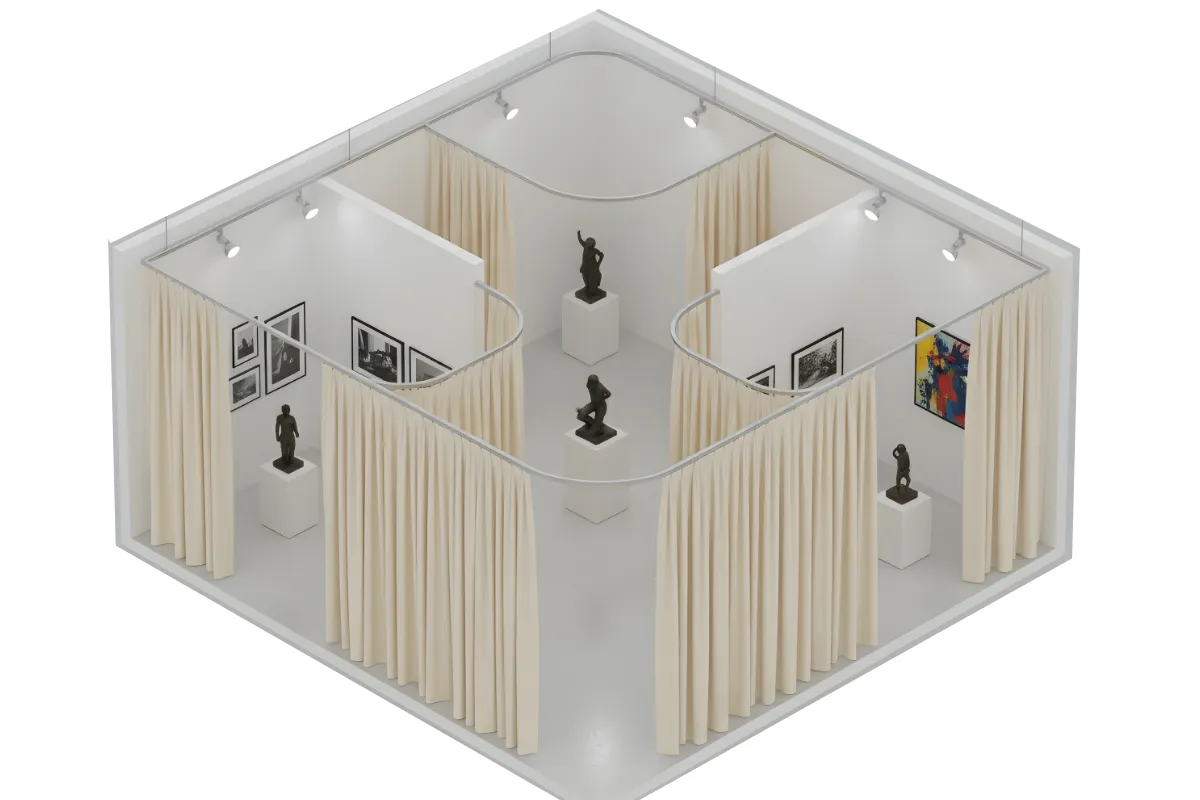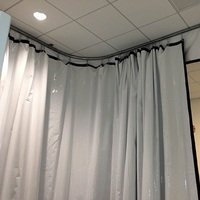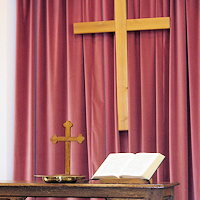Museum Exhibit Curtains
Museum Exhibit Divider Curtains provide a flexible, elegant way to separate displays, guide visitors, and conceal staff areas. In this guide, you’ll learn what they are, how they benefit museum layouts, how they compare to traditional partitions, and which custom options best suit your exhibits.
What Are Museum Exhibit Divider Curtains?
Now that you know why flexibility is essential in museum layouts, let’s take a closer look at what these curtains are and how they’re designed to fit within exhibit spaces. They provide a smart way to shape galleries, define zones, and maintain a calm, professional environment for both curators and visitors.
What They Are
Museum Exhibit Divider Curtains are large, custom-fabric panels that help museums organize and reshape their layouts without the need for new walls. Each curtain moves quietly along a ceiling or beam-mounted track, allowing curators to adjust displays, guide visitors, and manage space while keeping the gallery open and inviting.
They’re designed to adapt effortlessly to both permanent and rotating exhibits, giving museums long-term flexibility without structural changes.
How They’re Made
Each divider curtain is built from durable yet lightweight materials that balance practicality with visual subtlety. Fabrics can absorb sound, control lighting, and coordinate with exhibit colors or textures.
Every system is custom-sized for the specific space, creating a seamless, museum-quality look that blends naturally with the artwork and enhances the viewing experience. The result is a professional, polished installation that complements your exhibit design while maintaining durability for everyday use.
Why Museum Exhibit Divider Curtains Are Worth It
Beyond simple partitioning, these curtains elevate how museums organize, protect, and present their exhibits. They add function without disrupting beauty, helping curators manage space in ways that feel natural to both staff and visitors.
Versatile Applications: These curtains work beautifully in both permanent museums and temporary exhibitions. They allow curators to reimagine spaces without construction or disruption. Whether used for long-term displays or rotating collections, they easily adapt to new creative layouts.
Low Maintenance: The fabric surfaces are simple to clean and maintain, saving valuable staff time. Even after frequent use, they resist fading and retain their smooth appearance. This lasting quality makes them a reliable, cost-effective investment for busy museum teams.
Quiet Operation: The smooth-gliding tracks move silently, preserving the peaceful atmosphere visitors expect in a museum. The fabric helps absorb background sounds, reducing echo and noise in open halls. This contributes to a calm, focused environment where attention stays on the art itself.
Flexibility
Reconfigure pathways, divide displays, or create guided tours quickly. Adjust layouts anytime to match new exhibits or events.
Visitor Experience
Keep spaces open and visually calm while guiding foot traffic. Curtains shape gentle flow that supports a comfortable viewing journey.
Cost and Time Efficiency
Keep spaces open and visually calm while guiding foot traffic. Curtains shape gentle flow that supports a comfortable viewing journey.
Material Options

Vinyl
In areas where getting the curtain dirty is a concern we have the 18oz Vinyl curtains. Its slick surface makes it easy to clean and it is resistant to water spray. Unlike the fabric materials its surface is more reflective and shiny. This is the workhorse material that is made for less than ideal conditions. 100% Visual blackout, 90% Light blackout. $$
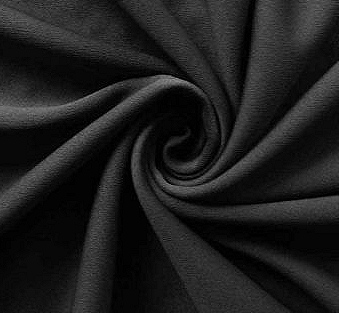
Fabric | Poly Stretch
Poly Stretch 6oz is a soft material commonly used in many commercial and industrial photo applications. It’s a two-way stretch fabric with zero, to minimal wrinkle and it has a flat matte finish. It is commonly used to create backdrop walls for photography of large products like automobiles. 75% Visual blackout, 50% Light blackout. $$

Fabric | Premium Velour
This luxurious 14oz fabric is ideal for stage backdrops, dividing a space or creating a high-end look with fabric. It's inherently flame resistant, lightweight and washable. It's the ideal fabric for commercial curtains that need to look great at a reasonable price. 100% Visual blackout, 90% Light blackout. $$$
Divider Curtains vs Traditional Partition Methods
After knowing how these curtains enhance museum layouts, it’s helpful to compare them with traditional partitions often used in exhibit design. The difference highlights just how much flexibility and long-term value Museum Exhibit Divider Curtains bring to modern galleries.
| Feature | Divider Curtains | Traditional Walls or Rigid Partitions |
|---|---|---|
| Installation Time | Quick to install, usually within hours or a day, allowing exhibits to stay open during setup. | Requires days or weeks of construction, often disrupting museum operations. |
| Flexibility | Easily adjusted to create new layouts, visitor paths, or private sections whenever needed. | Fixed and permanent, making layout changes difficult or costly. |
| Cost | More affordable overall due to simpler installation and lower material use. | Higher expenses for materials, labor, and potential future renovations. |
| Aesthetic Impact | Subtle and unobtrusive, blending seamlessly with the museum’s design. | Can appear bulky or intrusive, drawing attention away from the displays. |
| Maintenance | Simple to clean and replace when needed, keeping the space fresh and professional. | Requires regular painting or repairs, leading to higher upkeep costs. |
Unlike solid partitions, Museum Exhibit Divider Curtains create structure without visual weight. They preserve the open, welcoming atmosphere that museums strive for, keeping attention centered on the exhibits rather than the barriers that define them.
Explore the Best Curtain Materials for Modern Museum Spaces
After knowing how divider curtains outperform traditional walls, it’s time to look at the materials that make them truly versatile for museum spaces. Each option below offers a unique balance of durability, design, and performance, helping curators choose the best fit for their exhibit needs.
Vinyl
Built for high-traffic environments, vinyl curtains deliver outstanding durability with a smooth, modern finish. They’re perfect for dividing exhibit halls or concealing service areas while keeping layouts clean and professional.
• Highly durable and resistant to moisture and daily wear.
• Easy to clean and maintain between exhibit rotations.
• Smooth surface complements contemporary gallery interiors.
• Ideal for large spaces that require privacy without heavy construction.
Fabric | Poly Stretch
Lightweight and flexible, poly stretch curtains bring a refined, modern aesthetic to museum layouts. Their slightly elastic design allows seamless fitting around curved walls, corners, or creative display setups.
• Soft, sleek texture blends effortlessly into any gallery environment.
• Offers gentle light diffusion that enhances artwork visibility.
• Perfect for rotating or themed exhibits needing quick setup changes.
• Maintains a balanced look that complements both modern and classic designs.
Fabric | Premium Velour
For elegant galleries and acoustic-sensitive areas, premium velour curtains add a luxurious finish while improving sound quality. Their deep, rich tones and plush texture create an elevated experience that enhances visual and auditory comfort.
• Soft, high-end fabric helps control echo and ambient noise.
• Adds warmth and sophistication to high-traffic display areas.
• Available in rich colors that blend with any curated theme.
• Durable and dependable for long-term or semi-permanent installations.
Frequently Asked Questions
FAQs: Common Questions About Museum Exhibit Divider Curtains
Can Museum Exhibit Divider Curtains match our museum’s aesthetic?
Yes. You can choose from vinyl, poly stretch, or premium velour fabrics in a wide range of colors and textures. Each option is custom-made to complement your gallery’s interior design and exhibit themes.
Are Museum Exhibit Divider Curtains suitable for hiding staff or storage areas?
Absolutely. They are perfect for concealing prep zones, maintenance spaces, and staff-only areas while maintaining a clean, cohesive look that blends with public-facing exhibits.
Do Museum Exhibit Divider Curtains require professional installation?
Most setups do not. These systems use ceiling or beam-mounted track hardware that can be installed by in-house staff or maintenance teams with minimal tools.
Are these curtains fire-rated for museum safety?
Yes. Every curtain is made from NFPA-701 certified, fire-resistant, and low-emission materials, meeting strict safety standards for museums and public galleries.
Can these curtains include custom prints or exhibit graphics?
Yes. You can request custom-printed vinyl or poly stretch curtains to feature branding, artwork, or directional signage that enhances the visitor experience.
What are the main material options for museum use?
Three materials stand out: vinyl for durability, poly stretch for smooth flexibility, and premium velour for an elegant, sound-absorbing finish ideal for quiet galleries.
Can Museum Exhibit Divider Curtains help reduce noise inside the gallery?
Yes. The premium velour fabric provides natural sound absorption, helping maintain the peaceful atmosphere that visitors expect in exhibit halls.
Are Museum Exhibit Divider Curtains suitable for both permanent and traveling exhibits?
Definitely. The lightweight materials and modular track system make them ideal for both fixed galleries and temporary or mobile exhibits.
How do these curtains affect exhibit lighting?
They are made from light-filtering fabrics that reduce glare without blocking visibility. This helps preserve delicate artworks while maintaining a balanced viewing environment.
Can the curtains handle humidity or temperature changes?
Yes. Vinyl and poly stretch fabrics are moisture-resistant, making them suitable for climate-controlled or high-traffic museum areas.
Are the curtains easy to clean and maintain?
Yes. Most materials require only light cleaning, such as wiping with a damp cloth or gentle vacuuming, to keep them fresh between exhibits.
How long do Museum Exhibit Divider Curtains last?
With proper care, they can last several years. The fabrics are designed for durability and frequent reconfiguration without losing shape or color.
Can these curtains be replaced or upgraded later?
Yes. Panels can be swapped, resized, or reprinted at any time, allowing your layout to evolve with future exhibit updates.
Can they help organize visitor flow in exhibit halls?
Absolutely. Divider curtains can be positioned to guide pathways, direct visitor traffic, or separate different zones without blocking visibility.
Are Museum Exhibit Divider Curtains movable after installation?
Yes. They glide smoothly along ceiling tracks, making it easy to open, close, or reposition sections as exhibit layouts change.
Do these curtains comply with building and safety codes?
Yes. All products meet commercial safety codes and are built from compliant materials suitable for public installations.
What color options are most popular for museums?
Neutral tones like gray, beige, and deep charcoal are commonly used. Custom colors are also available to match your gallery’s design palette.
Can divider curtains include both solid and transparent panels?
Yes. You can mix vinyl or fabric panels with clear PVC sections to maintain visibility while defining distinct exhibit zones.
What is the typical lead time for a custom curtain order?
Most custom Museum Exhibit Divider Curtains are ready within 2 to 4 weeks, depending on project size and fabric selection.
How can we request a quote or consultation?
You can contact the design team to discuss sizes, materials, and layout options. They will help you choose the best curtain system for your museum and provide a detailed quote.
Subtle Solutions for Modern Museums
A well-designed divider curtain does more than divide space, it enhances how a museum feels and functions. Museum Exhibit Divider Curtains let curators organize galleries, guide visitors naturally, and conceal staff areas while preserving the calm, open flow that defines a professional exhibit. Their refined materials and gentle movement blend seamlessly into any design, helping each display stand out without distraction. Contact us today to customize a curtain system that elevates your museum’s layout and visitor experience.

